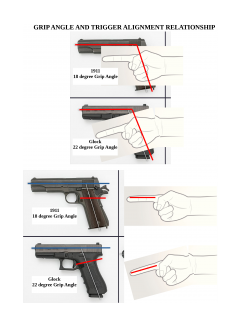ACIinventor
Elite
Ever wonder why Gaston Glock went with a 22 degree grip angle for his Glock pistols? Answer: Bad Trigger Alignment. It's the reason people are having their Glock grips modified to reproduce an 18 degree grip angle. Browning had it right with the 18 degree grip angle, the natural angle of a pointing hand. Glocks drive to produce a lower bore axis, a good thing for recoil control, is the culprit. Switching to a striker fired system eliminated the need for the space a hammer would occupy in the frame. This in turn, allowed the grip backstrap to curve much higher facilitating the shooter's high grip. But the trigger stayed low in the Glock creating bad alignment. Sure, adapting and training can compensate for the trigger alignment problem. But why go to that trouble when better trigger alignment can be designed into the handgun in the first place. To get your trigger finger correctly on a Glock, you have to torque your wrist down. This isn't natural.

